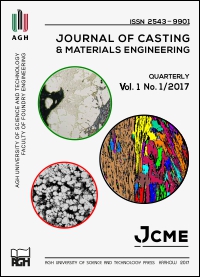TG-DTG-DSC, FTIR, DRIFT and Py-GC-MS studies of thermal decomposition for poly(sodium acrylate)/dextrin (PAANa/D) – new binder BioCo3
DOI:
https://doi.org/10.7494/jcme.2017.1.1.27Abstract
TG-DTG-DSC, FTIR, DRIFT, and Py-GC-MS studies have been conducted to determine the effect of the thermal decomposition
conditions and structure of foundry binder BioCo3 in the form of a composition poly(sodium acrylate)/dextrin
(PAANa/D) on the progress of degradation in terms of processes occurring in foundry sands in contact with liquid metal.
TG-DTG-DSC curves of the composition allowed us to determine the temperature range in which they do not undergo
degradation, by which they do not lose their binding properties. With temperature increasing, physical and chemical
changes occur that are related to the evaporation of solvent water (20–110°C), followed by the release of constitution
water, and finally intermolecular dehydration (110–230°C). In this temperature range, processes that are mainly reversible
take place. Within a temperature range of 450–826°C, polymer chains are decomposed, including the decomposition
of side chains. Within a temperature range of 399–663°C, polymer composition decomposition can be observed (FTIR,
DRIFT), and gas products are generated from this destruction (Py-GC-MS).
Downloads
References
Lewandowski J. L. (1995). Tworzywa na formy odlewnicze. Kraków: Akapit.
Zhou X., Yang J., Su D. & Qu G. (2009). The high-temperature resistant mechanism of α-starch composite binder for foundry. Journal of Materials Processing Technology, 209(14), 5394–5398. doi:10.1016/j.jmatprotec.2009.04.010
Fayomi O.S.I., Abdulwahab M. & Popoola A.P.I. (2014). Potentials of Elaeis guineensis and Pinus sylvestris as binders on foundry core strength. Journal of Scientific and Industrial Research, 73(3), 173–176. doi:10.5897/IJPS12.347
Miguel R.E., Ippolito J.A., Leytem A.B., Porta A.A., Banda Noriega R.B. & Dungan R.S. (2012). Analysis of total metals in waste molding and core sands from ferrous and non-ferrous foundries. Journal of Environmental Management, 110, 77–81. doi:10.1016/j.jenvman.2012.05.025
Dungan R.S., Kukier U. & Lee B. (2006). Blending foundry sands with soil: Effect on dehydrogenase activity. Science of the Total Environment, 357(1–3), 221–230. doi:10.1016/j. scitotenv.2005.04.032
Fox J.T., Cannon F.S., Brown N.R., Huang H. & Furness J.C. (2012). Comparison of a new, green foundry binder with conventional foundry binders. International Journal of Adhesion and Adhesives, 34, 38–45. doi:10.1016/j. ijadhadh.2011.11.011
Grabowska B., Szucki M., Suchy J.S., Eichholz S. & Hodor K. (2013). Thermal degradation behavior of cellulose-based material for gating systems in iron casting production.Polimery, 58(1), 39–44.
Kubecki M., Holtzer M. & Żymankowska S. (2013). Investigations of the Temperature Influence on Formation of Compounds from the BTEX Group During the Thermal Decomposition of Furan Resin. Archives of Foundry Engineering, 13(2), 85–90.
Bobrowski A., Holtzer M., Żymankowska-Kumon S. & Dańko R. (2015). Harmfulness assessment of moulding sands with a geopolymer binder and a new hardener, in an aspect of the emission of substances from the BTEX Group. Archives of Metallurgy and Materials, 60(1), 341–344. doi:10.1515/amm-2015-0056
Grabowska B., Holtzer M., Dańko, R. Górny M., Bobrowski A. & Olejnik E. (2013). New BioCo binders containing biopolymers for foundry industry. Metalurgija, 52(1), 47–50.
Grabowska B., Sitarz M., Olejnik E., Kaczmarska K. & Tyliszczak B. (2015). FT-IR and FT-Raman studies of cross-linking processes with Ca2+ ions, glutaraldehyde and microwave radiation for polymer composition of poly(acrylic acid)/sodium salt of carboxymethyl starch - In moulding sands, Part II. Spectrochimica Acta – Part A: Molecular and Biomolecular Spectroscopy, 151, 27–33. doi:10.1016/j.saa.2015.06.084
Pielichowski J. & Pielichowski K. (1995). Application of thermal analysis for the investigation of polymer degradation processes. Journal of Thermal Analysis, 43, 505–508.
Lattimer R.P. (2003). Pyrolysis mass spectrometry of acrylic acid polymers. Journal of Analytical and Applied Pyrolysis, 69(5), 3–14. doi:10.1016/S0165-2370(03)00080-9
Kader M.A. & Bhowmick A.K. (2003). Thermal ageing, degradation and swelling of acrylate rubber, fluororubber and their blends containing polyfunctional acrylates. Polymer Degradation and Stability, 79(2), 283–295. doi:10.1016/S0141-3910(02)00292-6
Lluch A.V., Felipe A.M., Greus A.R., Cadenato A., Ramis X., Salla J.M. & Morancho J.M. (2005). Thermal analysis characterization of the degradation of biodegradable starch blends in soil. Journal of Applied Polymer Science, 96(2), 358–371. doi:10.1002/app.21428
Lawal O.S., Lechner M.D. & Kulicke W.M. (2008). The synthesis conditions, characterizations and thermal degradation studies of an etherified starch from an unconventional source. Polymer Degradation and Stability, 93, 1520–1528. doi:10.1016/j.polymdegradstab.2008.05.010
Downloads
Published
Issue
Section
How to Cite
Accepted 2017-02-14
Published 2017-03-17


